Discover top guides, trends, tips and expertise from AIO Writers
How Does SEO and Content Marketing Work Together?
Farnaz Kia
Wednesday, 18th Sep 2024
Did you know that 75% of marketers consider SEO as their most effective content strategy, while 74% of companies say that content marketing has increased their lead generation?
But here’s the thing: these two strategies are not mutually exclusive. In fact, when combined, they can be a game-changer for your online presence.
So, how do you harness the power of SEO and content marketing to drive more traffic, generate more leads, and ultimately, boost your business growth?
In this post, we’ll dive into the world of SEO and content marketing, exploring how these two strategies work together in perfect harmony to drive real results.
Table Of Contents:
- First, What is SEO?
- Now What is Content Marketing?
- Content Marketing & SEO: Two Sides of the Same Coin
- How SEO and Content Marketing Intersect
- Benefits of Integrating SEO and Content Marketing
- How Do You Integrate SEO and Content Marketing?
- What Is an Example of SEO Friendly Content?
- How Do You Write SEO-Friendly Content?
- Best Practices for Integrating SEO and Content Marketing
- A Match Made in Heaven: Bringing SEO and Content Marketing Together
First, What is SEO?
SEO, which stands for search engine optimization, is how you tailor your website and online content to rank higher on search engine results pages (SERPs). It’s about making your brand more visible to people searching for information, products, or services related to what you offer.
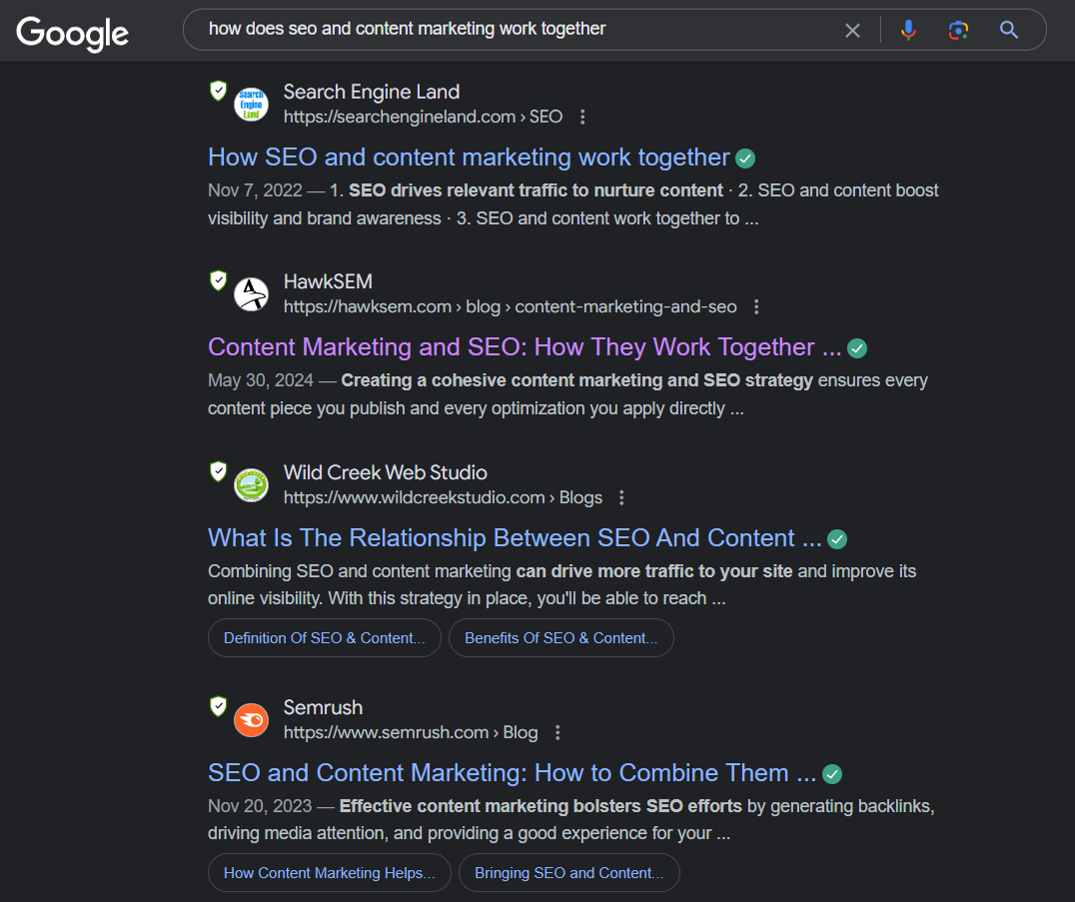
Organic search results on Google
Why is SEO Important?
Think about how you typically find information online. You probably head to Google, Bing, or another search engine and type in a phrase or question. In SEO parlance, these are called keywords.
As a business, you want your website and pages to show up in Google when potential customers type in those keywords. Why? Because Google Search, Images, and Maps are responsible for a whopping 92.96% of global traffic . And if your brand is displayed prominently in those search results, you’ll be snagging a nice chunk of that traffic for yourself.
Check out the click-through rates of each position on the first page of Google:
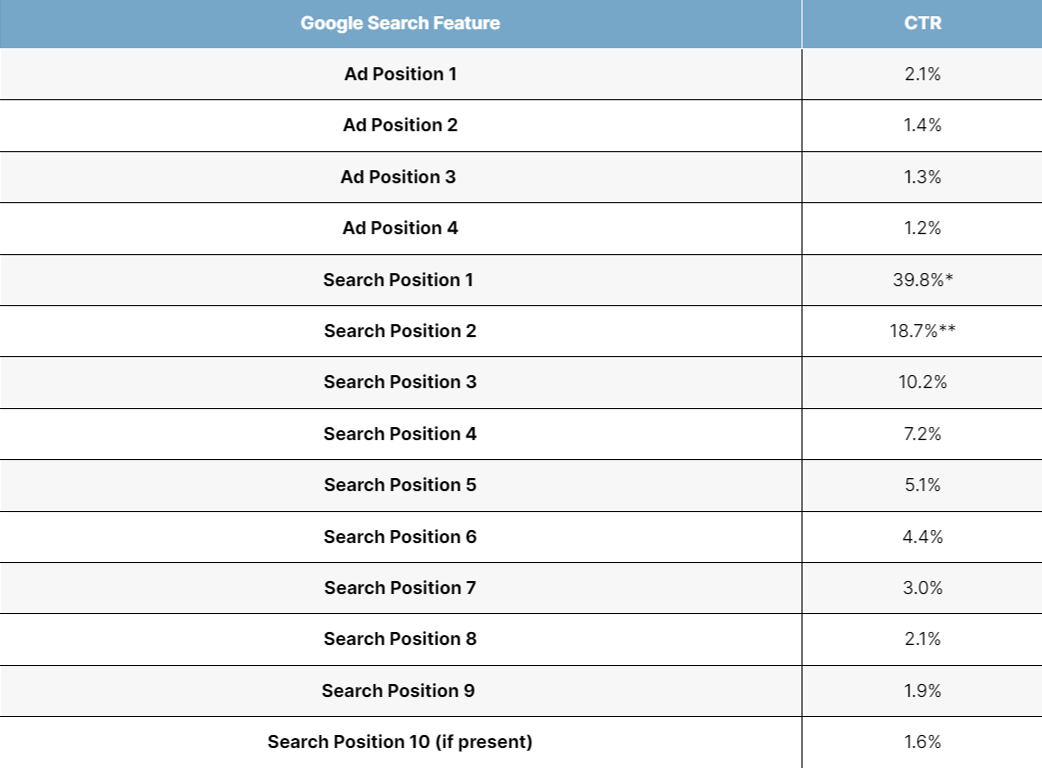
The number one organic position on Google almost gets 40% of all clicks! That’s the holy grail of SEO.
How Does SEO Work?
Search engines use complex algorithms to crawl, index, and rank websites. Here’s a simplified breakdown:
- Crawling: Search engines send out bots (like little digital explorers) to scan the vast expanse of the internet, discovering and indexing web pages.
- Indexing: These bots analyze your website’s content, structure, and other factors to understand what your website is about and who might find it relevant.
- Ranking: Based on hundreds of factors, search engines rank websites in order of relevance and authority for specific search queries. Websites deemed most relevant and trustworthy for a particular search term will appear higher on the SERP.
The goal of SEO is to get your web pages crawled, indexed, and ranked on the first page of Google. This involves optimizing various aspects of your content, including:
- Keywords: These are the words and phrases people use in search engines. When you create relevant content around those keywords, you increase your chances of being seen.
- Content: Creating high-quality, informative, and engaging content that satisfies user intent.
- Meta Tags: These behind-the-scenes snippets of code give search engines a summary of your content. They also impact what people see in search results, enticing them to click.
- Header Tags: Organizing your content into H1, H2, and H3 headers is important for readability and telling search engines the structure of your information.
- Technical SEO: Ensuring your website loads fast, is mobile-friendly, and has a secure connection.
- Backlinks: Links from reputable sites pointing back to your content tell search engines you’re a trusted source. They are an integral part of how SEO and content marketing work together.
Now What is Content Marketing?
Content marketing is not about selling or promoting your products or services directly. It’s about providing value to your target audience by crafting and sharing high-quality, informative, relevant, and engaging content.
This approach helps increase brand awareness, build trust and credibility, engage your audience, convert them into customers, and keep them coming back — ultimately driving revenue.
Types of Content
Content marketing encompasses everything you share online — from informative articles and listicles to how-to guides, product comparisons, product reviews, and case studies.
Podcasts, infographics, webinars, and videos offer unique forms of content that create engaging and informative experiences for your readers.
Popular types of online content include:
- Blog Posts : In-depth articles on a specific topic or industry.
- Videos : Educational, entertaining, or inspirational videos that showcase your brand’s personality.
- Infographics : Visual representations of data, statistics, or information.
- Podcasts : Audio content that discusses topics, trends, or interviews with experts.
- E-books : In-depth guides or reports on a specific topic or industry.
- Social Media Posts : Short-form content shared on social media platforms.
- Case Studies : Real-life examples of how your product or service has helped customers.
The Importance of High-Quality Content
You can’t just throw any content out there and expect amazing results. High-quality, original, relevant, and accurate information is key.
Your audience should learn something, solve a problem, be entertained, and leave satisfied after consuming your content.
They are more likely to trust and remember your brand if they enjoy reading your blog posts or watching your videos, eventually becoming loyal customers. It plays a vital role in how SEO and content marketing work together to boost brand success.
Content Marketing & SEO: Two Sides of the Same Coin
SEO and content marketing are often viewed as separate entities, but in reality, they are two sides of the same coin. While distinct in their approaches, they are most powerful when working together to achieve a shared goal: attracting your target audience and driving valuable actions.
Think of it this way:
- SEO is the foundation: It ensures your website is visible to search engines like Google. By optimizing technical and on-page SEO elements and building high-quality backlinks, SEO builds the framework for your content to be found.
- Content marketing is the message: It’s how you communicate with your audience. Through engaging and informative content like blog posts, videos, and infographics, you provide value, build trust, and ultimately guide users toward conversion.
Without SEO, even the most exceptional content might get lost in the vast digital landscape. Without content marketing, a perfectly optimized website can feel hollow and fail to resonate with visitors.
“SEO is not just about keywords and links. It’s about creating content that resonates with your audience and provides value to them. When you focus on creating high-quality content, the SEO benefits will follow naturally.” – Rand Fishkin, Co-Founder of Moz and SparkToro
How SEO and Content Marketing Intersect
So how does SEO and content marketing work together?
Keyword Research
As I earlier mentioned, keywords are the search terms that people type into Google when they want to find something. It’s a clue to what your target audience wants.
Keyword research tools like Google Keyword Planner and Answer The Public unearth these clues. These insights inform what topics you should cover and how to structure your content.
In SEO, keyword research is used to:
- Identify Relevant Keywords: Find keywords and phrases that people are searching for, and that are relevant to your business, product, or service.
- Optimize Content: Optimize website content, meta tags, and titles to rank higher in search engine results pages for target keywords.
- Improve Visibility: Increase visibility in search engines, driving organic traffic to your website.
In content marketing, keyword research is used to:
- Understand Audience Needs: Identify topics and keywords that resonate with your target audience, and create content that addresses their needs and pain points.
- Create Relevant Content: Develop content that is relevant, informative, and engaging, and that aligns with your audience’s interests and needs.
- Attract and Engage: Attract and engage your target audience with content that speaks to them, and drives conversions and loyalty.
Both SEO and content marketing rely on identifying relevant keywords that resonate with your target audience and understanding the search intent behind those phrases to create content that meets the user’s needs and expectations.
Remember to prioritize what users want, not just the search volume of specific terms. Use your keyword research to determine what your target audience is searching for.
Link Building
Imagine natural link juice in SEO flowing from authoritative sources toward your content. This comes from publishing excellent content that other sites want to reference in their articles. Engaging content naturally attracts organic backlinks from external sources, which contribute heavily to SEO.
In SEO, link building is used to:
- Increase Authority: Build high-quality backlinks to increase your website’s authority and ranking in search engines.
- Enhance Credibility: Enhance your website’s credibility and trustworthiness in the eyes of search engines.
In content marketing, link building is used to:
- Amplify Reach: Amplify the reach of your content, driving traffic and engagement to your website.
- Build Relationships: Build relationships with other websites, influencers, and industry leaders, establishing your brand as a thought leader.
To attract links from reputable sites, both SEO and content marketing rely on the following strategies:
- Create High-Quality Content: Create high-quality, informative, and engaging content that attracts links from other websites.
- Promote Content: Promote your content through various channels, including social media, email, and influencer outreach, to attract links.
- Write Guest Posts: Write articles for other blogs to attract links and build relationships with other websites and influencers.
- Resource Pages: Create resource pages that link to other high-quality websites, establishing your website as a hub of valuable information.
- Broken Link Building: Find broken links on other websites and offer to replace them with links to similar content on your own website.
Content Distribution
Content shouldn’t just sit on your website; it needs to be shared. SEO can help amplify your content’s reach, with platforms like LinkedIn, newsletters, and paid ads taking it to a broader audience.
In SEO, content distribution is used to:
- Improve Rankings: Improve rankings in search engines by increasing the number of high-quality backlinks to your website.
- Enhance Credibility: Enhance your website’s credibility and trustworthiness in the eyes of search engines.
In content marketing, content distribution is used to:
- Increase Brand Awareness: Reach a wider audience and increase brand awareness through targeted content distribution.
- Drive Engagement: Drive engagement and conversions through targeted content distribution to specific segments of your audience.
Distributing content wisely maximizes visibility, amplifies engagement, and attracts a wider audience to your site. This process showcases how SEO and content marketing work together.
“Content marketing is the creation of valuable, relevant, and consistent content to attract and retain a clearly defined audience. SEO is the process of optimizing that content to rank higher in search engines. You can’t have effective content marketing without SEO.” – Joe Pulizzi, Founder of Content Marketing Institute
Benefits of Integrating SEO and Content Marketing
We know search engines rely heavily on keywords to determine the relevance of content. We’ve seen how relevant and consistent content becomes a cornerstone for brand building and customer connection. But what are the tangible results of SEO and content marketing working together?
Improved Search Engine Rankings
Again, the goal is to snag a top spot in Google’s search results. The key is to match keywords with user intent. Optimized content caters to both search engines and readers and is more likely to attract clicks.
Statistics show the top organic result often receives about 34% of clicks on desktop and 31% on mobile . This illustrates how SEO and content marketing work together. Ranking higher attracts more website traffic, potentially converting browsers into customers.
Increased Conversions
Content that is written for a specific target audience, focused on their desires, answers questions and solves problems can lead to increased conversions. Research shows about 55% of buyers base purchasing decisions on the helpfulness of online content .
This highlights a key principle of how SEO and content marketing increase conversion. Creating value and addressing user intent directly boosts lead generation, engagement rates, and sales.
Enhanced Brand Authority
Consistent, high-quality, search-optimized content establishes your authority in your niche. This top-ranking visibility translates into trust for the consumer, which is the cornerstone of long-term brand building. Don’t create content just to fill your blog section as it will get lost in the vastness of the web.
Research shows that a stunning 68% of online traffic comes from searches . This demonstrates how often Google and other search engines become a user’s first point of contact with your brand.
Cost-Effective Approach
While some see SEO and content marketing as expenses, this duo is a smart investment. Attracting an audience through compelling, search-optimized content is a dynamic way to pull in relevant leads organically.
It’s also a cost-effective strategy compared to paid campaigns, highlighting a clear advantage of understanding how SEO and content marketing work together.
How Do You Integrate SEO and Content Marketing?
Want to rank higher on SERPs and drive organic traffic to your website? You need a solid SEO and content marketing strategy. But more than that, you need to know how to integrate them.
Think of it like peanut butter and jelly. Sure, you can enjoy each one on its own, but together they create something truly special. The same goes for SEO and content marketing.
SEO helps your content get found by search engines. Content marketing gives people a reason to visit and stay on your website. When you combine these two powerful digital marketing strategies, you create a sustainable system for attracting your target audience and achieving your marketing goals.
Think of it like a Venn diagram. SEO and content marketing are two overlapping circles, and the overlapping section is where the magic happens. That’s where you’ll find content that’s both optimized for search engines and valuable to your target audience.
When you consistently create high-quality content that’s optimized for both search engines and users, you’ll see a significant improvement in your website’s traffic, leads, and sales.
What Is an Example of SEO Friendly Content?
Imagine a user searching for the perfect pair of hiking boots online. They type in “best waterproof hiking boots” into Google. A blog post titled “Conquering the Trails: Your Guide to the Best Waterproof Hiking Boots” appears on the search engine results page.
Here’s how to make this a prime example of SEO-friendly content:
- Keyword Optimization: The blog post strategically incorporates relevant keywords like “waterproof hiking boots,” “best,” and “trails” throughout the content. This helps search engines understand the topic and relevance of the content to the user’s search query.
- High-Quality Content: The blog post provides valuable information, comparing different hiking boot brands, discussing features, and offering expert advice. This comprehensive approach satisfies user intent, keeping them engaged and on the page longer.
- User Experience: The content is well-structured with clear headings, bullet points, and concise paragraphs, making it easy to read and navigate. It also has beautiful pictures of hiking boots as well as links to other relevant content on the website such as product pages.
- Backlinks: Other reputable websites might link to this blog post as a valuable resource for hikers. These backlinks act as votes of confidence, signaling to search engines that the content is trustworthy and authoritative.
This combination of factors contributes to higher search engine rankings, increased organic traffic, and ultimately, a greater likelihood of converting readers into customers.
“The key to successful SEO is to create content that’s so good, people will want to link to it. When you focus on creating high-quality content, the links will follow naturally, and so will the rankings.” – Danny Sullivan, Founding Editor of Search Engine Land
How Do You Write SEO-Friendly Content?
Crafting compelling content that resonates with your target audience while also appealing to search engines is a delicate balancing act. It’s the art of combining best SEO practices with helpful content that humans genuinely want to read.
Think of it as creating a delicious meal – you need both flavor (engaging content) and proper presentation (SEO) for it to be truly satisfying.
The goal isn’t to trick Google’s algorithms; it’s about aligning your content with what people are actively searching for. Here’s how to strike that balance:
1. Understand Your Audience and Their Search Intent
Before you even think about keywords, consider your target audience.
What are their pain points, questions, and interests? What are they typing into the search bar?
Tools like Google Trends can offer valuable insights into popular search queries related to your industry.
2. Conduct Thorough Keyword Research
Keyword research is the backbone of SEO-friendly content. Identify relevant keywords and phrases with decent search volume and moderate competition.
If you’re using our brand growth tool, BrandWell , you will see both metrics on top of the keyword report:
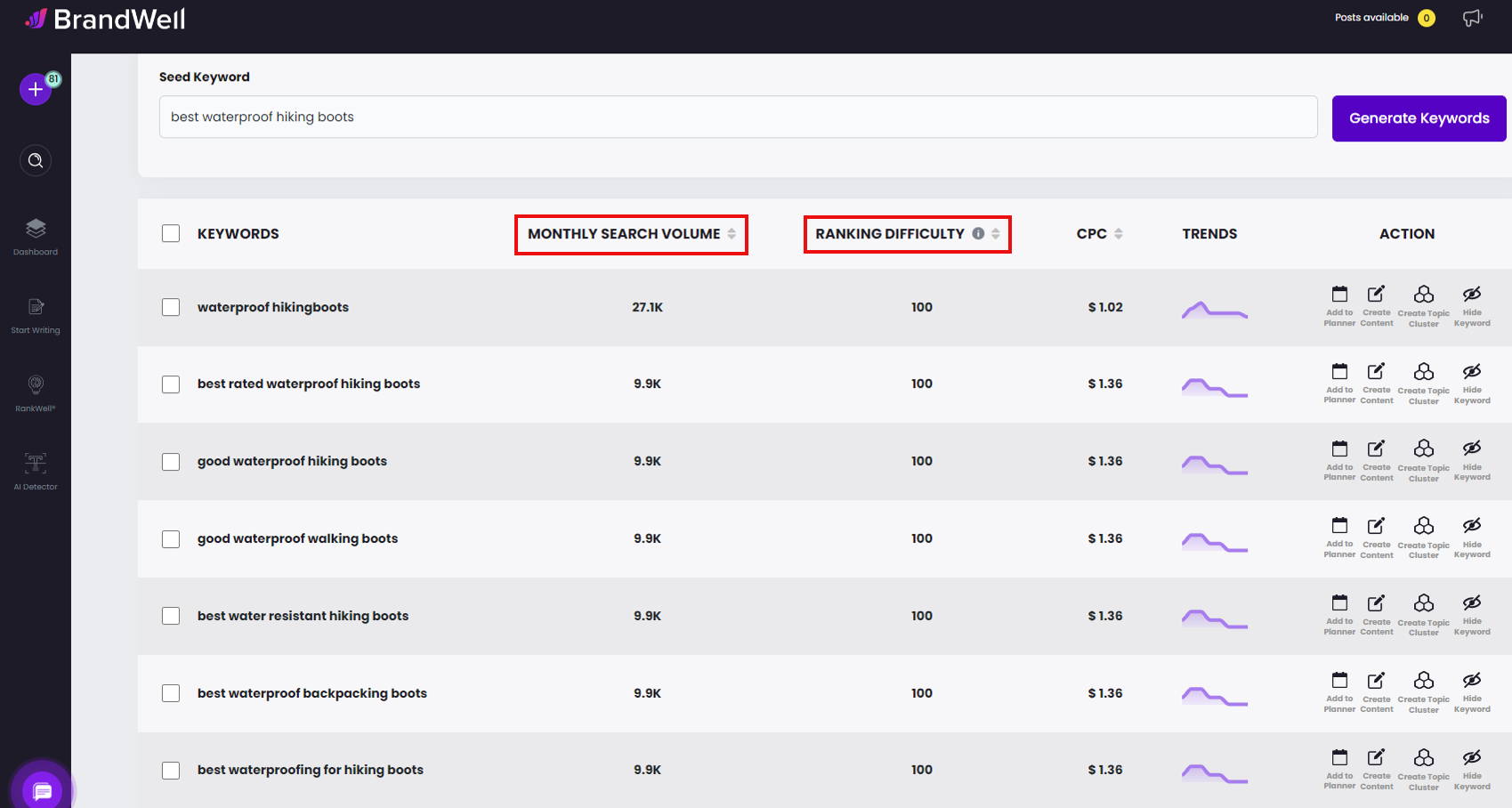
Focus on long-tail keywords (longer, more specific phrases) as they tend to attract more qualified traffic.
3. Integrate Keywords Naturally
Once you have your keywords, incorporate them naturally throughout your content.
Don’t force them where they don’t make sense — this can turn off readers and hurt your SERP rankings.
Aim for a conversational tone that feels natural to the reader.
What is the ideal number of times you should use a keyword in your content? Read our guides on keyword density and how to avoid keyword stuffing .
4. Optimize Your Content Structure
Search engines love well-structured content. Use clear headings (H1, H2, H3, etc.), bullet points, and short paragraphs to enhance readability and make it easier for search engines to understand your content’s hierarchy.
Best Practices for Integrating SEO and Content Marketing
Integrating SEO and content marketing is an ongoing journey, not a one-time task. It requires adapting to the evolving digital landscape and staying on top of changing user needs.
Create Targeted Content
Your content should speak to a specific segment of your audience to make sure it resonates with the right people. In our previous example of “best waterproof hiking boots,” some of the topics that may appeal to this audience include:
- “Top 10 Waterproof Hiking Boots for Men/Women: A Comprehensive Review” – a detailed review of the top-rated waterproof hiking boots for men or women, including features, pros, and cons.
- “How to Choose the Best Waterproof Hiking Boots for Your Next Adventure” – a guide on what to look for when selecting waterproof hiking boots, including materials, waterproofing technology, and fit.
- “Waterproof Hiking Boots vs. Water-Resistant Hiking Boots: What’s the Difference?” – a comparison of waterproof and water-resistant hiking boots, including the benefits and drawbacks of each.
- “The Best Waterproof Hiking Boots for Specific Terrain” – an article that recommends the best waterproof hiking boots for specific types of terrain, such as trails, mountains, or wet conditions.
- “How to Care for Your Waterproof Hiking Boots” – tips and tricks on how to clean, condition, and store waterproof hiking boots to keep them in good condition.
- “The Best Waterproof Hiking Boots for Different Budgets” – a review of waterproof hiking boots at different price points, including affordable, mid-range, and luxury options.
- “Waterproof Hiking Boots for Different Outdoor Activities” – a guide that recommends the best waterproof hiking boots for specific activities, such as hiking, backpacking, or trail running.
To help you figure out which topics resonate the most with your target audience, read this guide on how to create detailed customer personas .
Craft Engaging and Informative Content
High-quality content is crucial for both search engines and your audience. Create informative, well-researched, and engaging content that provides value to your readers.
Cover each topic in-depth and use internal links strategically to point your reader to more sources.
Break up long blocks of text with headings, subheadings, bullet points, and visuals. Ensure your content is easy to read and understand to keep your audience engaged.
Optimize Content for Search Intent
Optimizing content for search intent is all about understanding why people are searching for something and tailoring your content to match that intent.
Search intent usually falls into four categories: informational (looking for answers), navigational (searching for a specific website), transactional (ready to buy), or commercial (researching before buying).
The first step in optimizing content for search intent is analyzing keywords and the search results that come up.
For example, if you’re targeting the keyword “best smartphones 2024,” it’s likely a commercial intent since users are researching options before making a purchase. In this case, your content should compare different smartphones and highlight the pros and cons, rather than just providing a product page.
Another key part of search intent optimization is structuring your content to quickly satisfy what the user is looking for.
If the intent is informational, like “how to grow indoor plants,” ensure your content is clear, concise, and provides step-by-step instructions. Use headings, bullet points, and visuals to break down information, so users can easily find what they need.
A well-optimized piece would answer questions directly but also offer deeper insights for those who want more. For instance, you might include an FAQ section at the bottom or link to related articles. Google rewards this kind of user-focused content with higher rankings because it keeps people engaged and satisfied with their search experience.
Repurpose and Update
Older content might need a refresh with updated keywords or data. Updating ensures its ongoing value and keeps attracting organic traffic.
BrandWell makes this process easy by crawling your entire website, building a comprehensive brand graph, and understanding what you write about – plus how you write it, and what’s missing – so you can branch out into deeper authoritative topics. The AI will run optimization audits on all your existing content, and identify which pieces need to be improved.
Get real-time insights for your content strategy and optimize all your old content at the touch of a button.
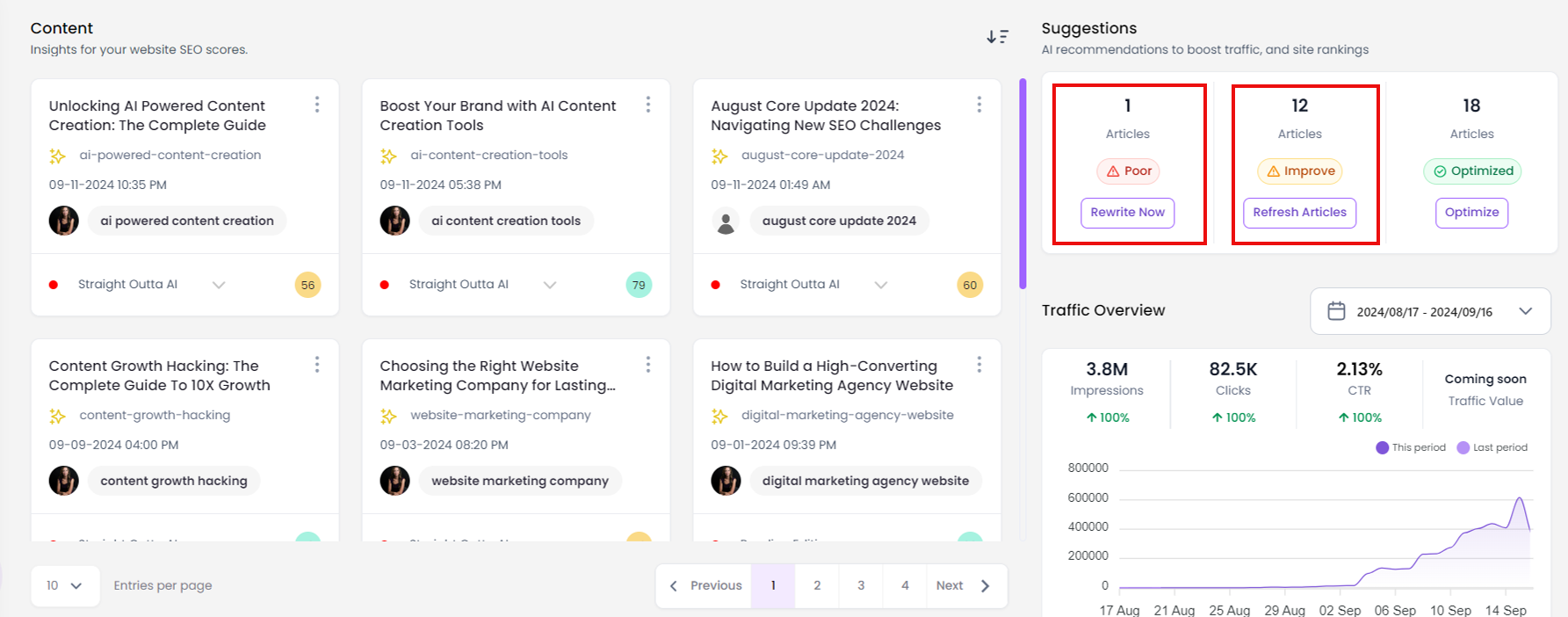
Repurposing content helps you reach a wider audience. Imagine transforming a compelling blog post into a catchy infographic or turning its core insights into a script for an explainer video.
BrandWell’s long-form content writer can help you turn your top-performing pieces into a fresh blog post, with the option to include additional research from top-ranking content.
Just enter the URL of your published work or upload the digital file and the AI will turn it into a shiny new piece.
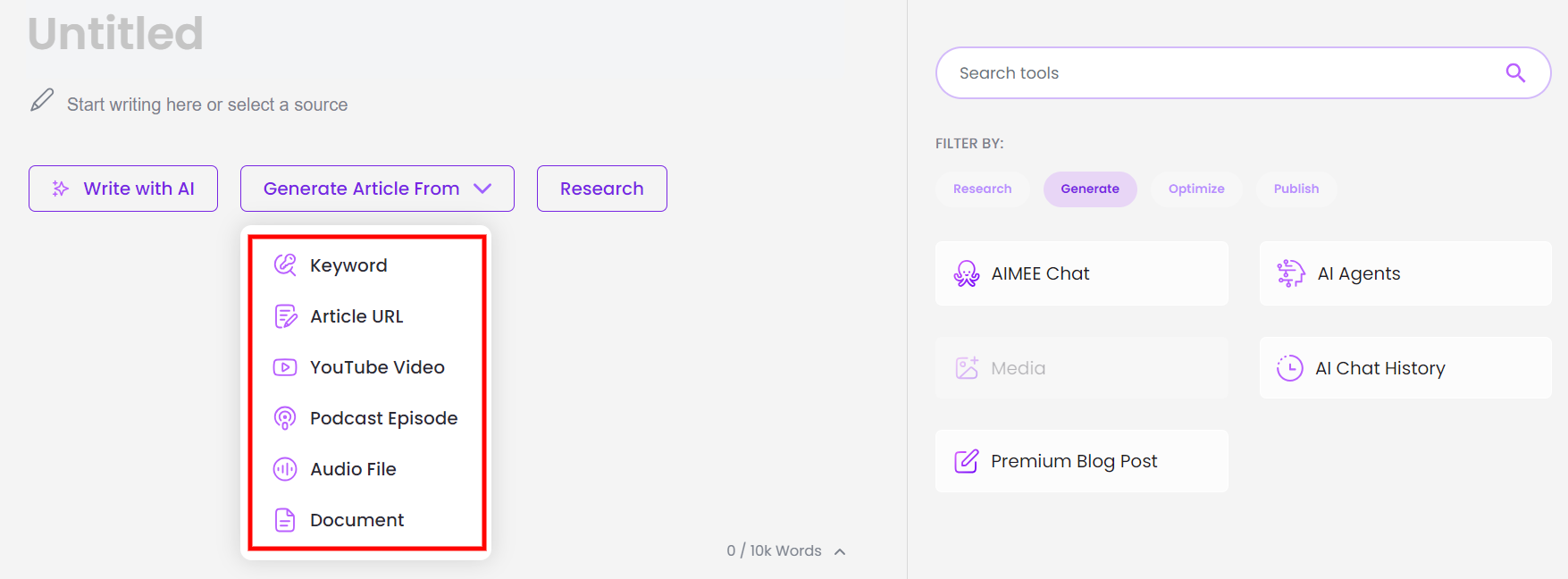
Track and Measure
A well-crafted content marketing strategy aligned with your SEO goals can significantly elevate your online presence and drive business growth. But how do you know if your efforts are paying off? That’s where tracking and measuring your success come in.
Regularly monitoring key metrics provides valuable insights into what’s working, what’s not, and where you can optimize your approach. Think of it as fine-tuning your engine for peak performance.
While the specific metrics you prioritize will depend on your unique goals, here are some essential ones to consider:
- Website Traffic: This metric tells you how many people are visiting your website. Tools like Google Analytics can break down your traffic sources, showing you how much is coming from organic search (thanks to your SEO efforts!), social media, referrals, and more.
- Keyword Rankings: Curious how you rank for specific keywords relevant to your business? Tools like Semrush or Ahrefs can track your keyword rankings over time, showing you which keywords are bringing in organic traffic and which ones need more attention. Improving your rankings can lead to higher visibility and more organic traffic.
- Engagement Rates: This goes beyond just getting people to your website; it’s about keeping them engaged. Track metrics like average time on page, bounce rate (how quickly people leave your site), and pages per session to gauge how well your content resonates with your audience. High engagement often translates to a better user experience and can signal to search engines that your content is valuable.
- Backlinks: Backlinks are like votes of confidence from other websites. When a reputable site links to your content, it signals to search engines that your content is valuable and trustworthy. Use tools like Moz to monitor your backlink profile, identifying opportunities to earn high-quality backlinks and boost your domain authority.
A Match Made in Heaven: Bringing SEO and Content Marketing Together
Everyone knows content is king. At the same time, it’s hard to understate the importance of SEO in digital marketing.
Even in a world where AI is impacting how we search for information, the need to rank in SERPs and build organic visibility through search engines remains paramount.
SEO and content marketing are not standalone strategies. They are complementary forces that create a powerful synergy for online success.
By weaving SEO principles into your content marketing strategy, you can:
- Improve your website’s visibility in search engine results pages
- Attract more qualified organic traffic
- Establish your brand as a thought leader in your industry
- Drive more conversions and revenue
This powerful duo allows you to connect with your audience at every stage of their buyer journey. Content marketing helps you build trust and credibility, while SEO ensures your content reaches the right people at the right time. It’s a win-win situation for both your audience and your business.
If you need help integrating the two, consider working with a growth marketing tool like BrandWell which specializes in SEO and content strategy. It can help you capitalize on each content-related initiative and ensure that it enhances both your brand’s authority and visibility in the process.
\

UNLOCK YOUR POTENTIAL
Long Headline that highlights Value Proposition of Lead Magnet
Grab a front row seat to our video masterclasses, interviews, case studies, tutorials, and guides.


